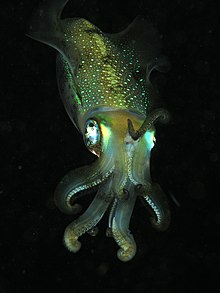Malacology[1] is the branch of invertebrate zoology that deals with the study of the Mollusca (mollusks or molluscs), the second-largest phylum of animals in terms of described species[2] after the arthropods. Mollusks include snails and slugs, clams, and cephalopods, along with numerous other kinds, many of which have shells. One division of malacology, conchology, is devoted to the study of mollusk shells. Malacology derives from Ancient Greek μαλακός (malakós) 'soft', and -λογία (-logía).
Fields within malacological research include taxonomy, ecology and evolution. Applied malacology studies medical, veterinary, and agricultural applications; for example, mollusks as vectors of disease, as in schistosomiasis.
Archaeology employs malacology to understand the evolution of the climate, the biota of the area, and the usage of the site.
In 1681, Filippo Bonanni wrote the first book ever published that was solely about seashells, the shells of marine mollusks.[3]The book was entitled: Ricreatione dell' occhio e dela mente nell oservation' delle Chiociolle, proposta a' curiosi delle opere della natura, &c.[4] In 1868, the German Malacological Society was founded.
Zoological methods are used in malacological research. Malacological field methods and laboratory methods (such as collecting, documenting and archiving, and molecular techniques) were summarized by Sturm et al. (2006).[5]
https://en.wikipedia.org/wiki/Malacology
Hermann Eduard Anton (17 December 1794 in Görlitz – 24 March 1872 in Halle) was a German malacologist.[1][2]
Works[edit]
- Anton H. E. (1839). Verzeichniss der Conchylien. Halle, xvi + 110 pp.
Some authors consider the work to be published in 1838 while others in 1839.[3]
Taxa described[edit]
Taxa described by Hermann Eduard Anton include (sorted chronologically):
1838
- Bonellia obtusa Anton, 1838
- Cardiocardita Anton, 1838
- Clanculus miniatus (Anton, 1838)
- Echinolittorina reticulata (Anton, 1838)
- Eulima dubia Anton, 1838
- Eulima incerta Anton, 1838
- Fasciolaria magna (Anton, 1838)
- Fasciolaria sulcata (Anton, 1838)
- Fusinus indicus (Anton, 1838)
- Isognomon radiatus (Anton, 1838)
- Latirus fenestratus (Anton, 1838)
- Latirus impressus (Anton, 1838)
- Latirus plicatulus (Anton, 1838)
- Monoplex wiegmanni (Anton, 1838)
- Nerita planospira Anton, 1838
- Ostrea imputata Anton, 1838
- Oxystele tigrina (Anton, 1838)
- Oxystele variegata (Anton, 1838)
- Pecten excavatus Anton, 1838
- family Siliquariidae Anton, 1838
- Tectonatica tecta (Anton, 1838)
- Turbinella laevigata Anton, 1838[4]
- Turridrupa cerithina (Anton, 1838)
- Vasum tubiferum (Anton, 1838)
- Vexillum cancellarioides (Anton, 1838)
- Vexillum interruptum (Anton, 1838)
- Vexillum semicostatum (Anton, 1838)
1839
- Asolene pulchella (Anton, 1839)
- Cantharus wagneri (Anton, 1839)
- Pollia wagneri (Anton, 1839)
1848
- Euchelus pullatus Anton, 1848
References[edit]
- ^ "Anton, Hermann Eduard". Deutsche Biographie, accessed 9 February 2013.
- ^ Coan E. V., Kabat A. R. & Petit R. E. (15 February 2009). 2,400 years of malacology, 6th ed., 830 pp. & 32 pp. [Annex of Collations]. American Malacological Society
- ^ "Reference summary for Anton, H. E. 1839". AnimalBase, accessed 9 February 2013.
- ^ Anton H. E. (1839). Verzeichniss der Conchylien. Halle, xvi + 110 pp.
https://en.wikipedia.org/wiki/Hermann_Eduard_Anton

No comments:
Post a Comment